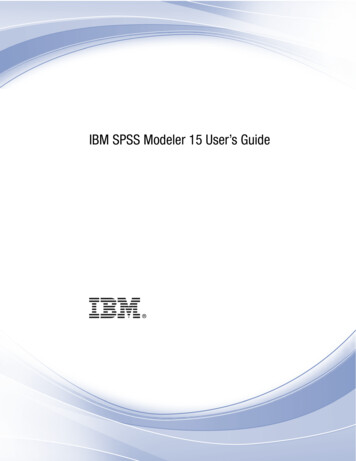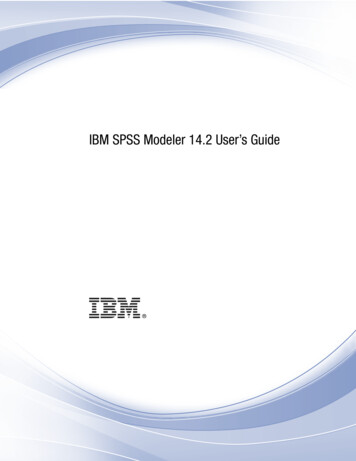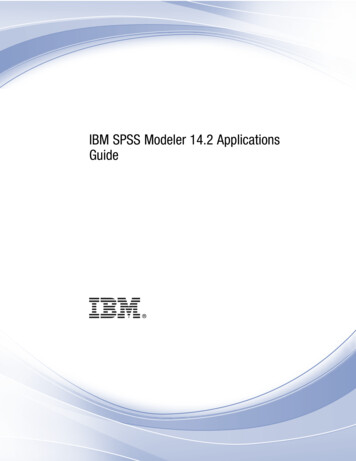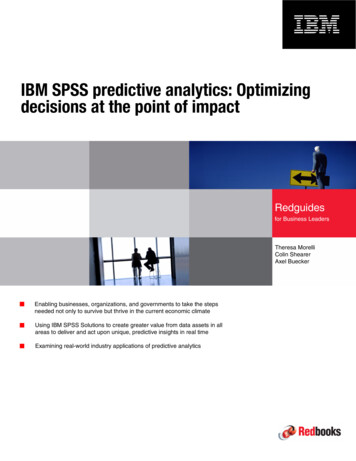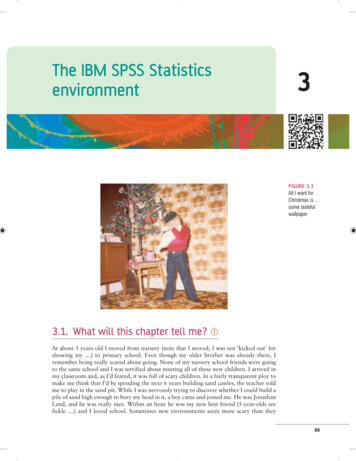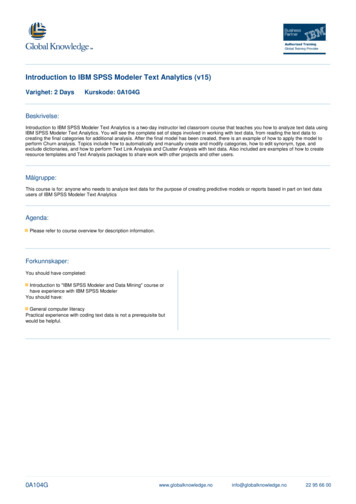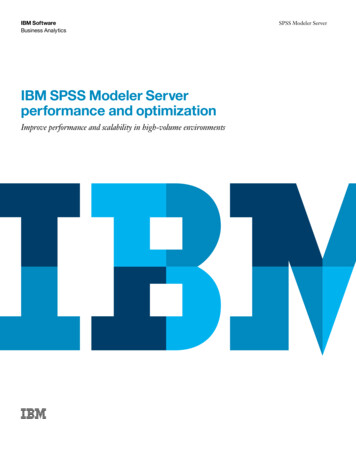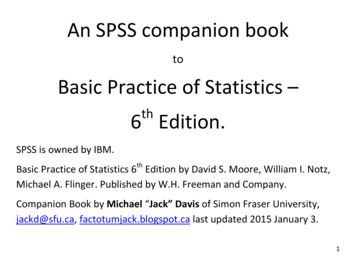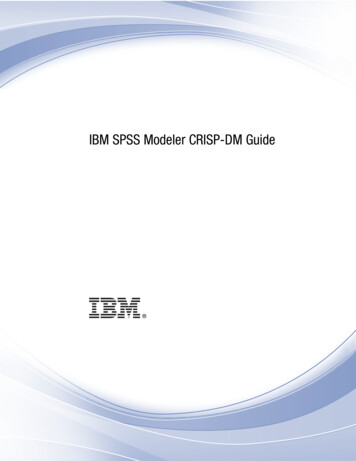
Transcription
iIBM SPSS Modeler CRISP-DM Guide
Note: Before using this information and the product it supports, read the general informationunder Notices on p. 40.This edition applies to IBM SPSS Modeler 15 and to all subsequent releases and modificationsuntil otherwise indicated in new editions.Adobe product screenshot(s) reprinted with permission from Adobe Systems Incorporated.Microsoft product screenshot(s) reprinted with permission from Microsoft Corporation.Licensed Materials - Property of IBM Copyright IBM Corporation 1994, 2012.U.S. Government Users Restricted Rights - Use, duplication or disclosure restricted by GSA ADPSchedule Contract with IBM Corp.
PrefaceIBM SPSS Modeler is the IBM Corp. enterprise-strength data mining workbench. SPSSModeler helps organizations to improve customer and citizen relationships through an in-depthunderstanding of data. Organizations use the insight gained from SPSS Modeler to retainprofitable customers, identify cross-selling opportunities, attract new customers, detect fraud,reduce risk, and improve government service delivery.SPSS Modeler’s visual interface invites users to apply their specific business expertise, whichleads to more powerful predictive models and shortens time-to-solution. SPSS Modeler offersmany modeling techniques, such as prediction, classification, segmentation, and associationdetection algorithms. Once models are created, IBM SPSS Modeler Solution Publisherenables their delivery enterprise-wide to decision makers or to a database.About IBM Business AnalyticsIBM Business Analytics software delivers complete, consistent and accurate information thatdecision-makers trust to improve business performance. A comprehensive portfolio of businessintelligence, predictive analytics, financial performance and strategy management, and analyticapplications provides clear, immediate and actionable insights into current performance and theability to predict future outcomes. Combined with rich industry solutions, proven practices andprofessional services, organizations of every size can drive the highest productivity, confidentlyautomate decisions and deliver better results.As part of this portfolio, IBM SPSS Predictive Analytics software helps organizations predictfuture events and proactively act upon that insight to drive better business outcomes. Commercial,government and academic customers worldwide rely on IBM SPSS technology as a competitiveadvantage in attracting, retaining and growing customers, while reducing fraud and mitigatingrisk. By incorporating IBM SPSS software into their daily operations, organizations becomepredictive enterprises – able to direct and automate decisions to meet business goals and achievemeasurable competitive advantage. For further information or to reach a representative visithttp://www.ibm.com/spss.Technical supportTechnical support is available to maintenance customers. Customers may contact TechnicalSupport for assistance in using IBM Corp. products or for installation help for one of thesupported hardware environments. To reach Technical Support, see the IBM Corp. web siteat http://www.ibm.com/support. Be prepared to identify yourself, your organization, and yoursupport agreement when requesting assistance. Copyright IBM Corporation 1994, 2012.iii
Contents1Introduction to CRISP-DM1CRISP-DM Help Overview. . . . . . . . . . . . . . . . . . . . . . . . . . . . . . . . . . . . . . . . . . . . . . . . . . . . . . . 1CRISP-DM in IBM SPSS Modeler. . . . . . . . . . . . . . . . . . . . . . . . . . . . . . . . . . . . . . . . . . . . . . 1Additional Resources. . . . . . . . . . . . . . . . . . . . . . . . . . . . . . . . . . . . . . . . . . . . . . . . . . . . . . . 32Business Understanding4Business Understanding Overview . . . . . . . . . . . . . . . . . . . . . . . . . . . . . . . . . . . . . . . . . . . . . . . . 4Determining Business Objectives . . . . . . . . . . . . . . . . . . . . . . . . . . . . . . . . . . . . . . . . . . . . . . . . . 43E-Retail Example—Finding Business Objectives. .Compiling the Business Background . . . . . . . . . .Defining Business Objectives. . . . . . . . . . . . . . . .Business Success Criteria . . . . . . . . . . . . . . . . . .Assessing the Situation . . . . . . . . . . . . . . . . . . . . . . .45666E-Retail Example—Assessing the Situation . .Resource Inventory . . . . . . . . . . . . . . . . . . . .Requirements, Assumptions, and Constraints.Risks and Contingencies . . . . . . . . . . . . . . . .Terminology . . . . . . . . . . . . . . . . . . . . . . . . . .Cost/Benefit Analysis. . . . . . . . . . . . . . . . . . .Determining Data Mining Goals . . . . . . . . . . . . . .7788999Data Mining Goals . . . . . . . . . . . . . . . . . .E-Retail Example—Data Mining Goals . . .Data Mining Success Criteria . . . . . . . . .Producing a Project Plan . . . . . . . . . . . . . . . .10101011Writing the Project Plan. . . . . . . .Sample Project Plan . . . . . . . . . .Assessing Tools and Techniques .Ready for the next step? . . . . . . . . . . .11111212.13Data UnderstandingData Understanding Overview . . . . . . . . . . . . . . . . . . . . . . . . . . . . . . . . . . . . . . . . . . . . . . . . . . . 13Collecting Initial Data . . . . . . . . . . . . . . . . . . . . . . . . . . . . . . . . . . . . . . . . . . . . . . . . . . . . . . . . . . 13E-Retail Example—Initial Data Collection. . . . . . . . . . . . . . . . . . . . . . . . . . . . . . . . . . . . . . . . 14Writing a Data Collection Report . . . . . . . . . . . . . . . . . . . . . . . . . . . . . . . . . . . . . . . . . . . . . . 14 Copyright IBM Corporation 1994, 2012.iv
Describing Data . . . . . . . . . . . . . . . . . . . . . . . . . . . . . . . . . . . . . . . . . . . . . . . . . . . . . . . . . . . . . . 14E-Retail Example—Describing Data . . . . . . . . . . . . . . . . . . . . . . . . . . . . . . . . . . . . . . . . . . . . 15Writing a Data Description Report . . . . . . . . . . . . . . . . . . . . . . . . . . . . . . . . . . . . . . . . . . . . . 15Exploring Data . . . . . . . . . . . . . . . . . . . . . . . . . . . . . . . . . . . . . . . . . . . . . . . . . . . . . . . . . . . . . . . 16E-Retail Example—Exploring Data . . . . . . . . . . . . . . . . . . . . . . . . . . . . . . . . . . . . . . . . . . . . . 16Writing a Data Exploration Report . . . . . . . . . . . . . . . . . . . . . . . . . . . . . . . . . . . . . . . . . . . . . 16Verifying Data Quality . . . . . . . . . . . . . . . . . . . . . . . . . . . . . . . . . . . . . . . . . . . . . . . . . . . . . . . . . . 17E-Retail Example—Verifying Data Quality. . . . . . . . . . . . . . . . . . . . . . . . . . . . . . . . . . . . . . . . 17Writing a Data Quality Report. . . . . . . . . . . . . . . . . . . . . . . . . . . . . . . . . . . . . . . . . . . . . . . . . 18Ready for the next step? . . . . . . . . . . . . . . . . . . . . . . . . . . . . . . . . . . . . . . . . . . . . . . . . . . . . . . . . 184Data Preparation19Data Preparation Overview. . . . . . . . . . . . . . . . . . . . . . . . . . . . . . . . . . . . . . . . . . . . . . . . . . . . . . 19Selecting Data . . . . . . . . . . . . . . . . . . . . . . . . . . . . . . . . . . . . . . . . . . . . . . . . . . . . . . . . . . . . . . . 19E-Retail Example—Selecting Data . . . . . . . . . . . . . . . . . . . . . . . . . . . . . . . . . . . . . . . . . . . . . 19Including or Excluding Data . . . . . . . . . . . . . . . . . . . . . . . . . . . . . . . . . . . . . . . . . . . . . . . . . . 20Cleaning Data . . . . . . . . . . . . . . . . . . . . . . . . . . . . . . . . . . . . . . . . . . . . . . . . . . . . . . . . . . . . . . . . 20E-Retail Example—Cleaning Data . . . . . . . . . . . . . . . . . . . . . . . . . . . . . . . . . . . . . . . . . . . . . 20Writing a Data Cleaning Report . . . . . . . . . . . . . . . . . . . . . . . . . . . . . . . . . . . . . . . . . . . . . . . 21Constructing New Data. . . . . . . . . . . . . . . . . . . . . . . . . . . . . . . . . . . . . . . . . . . . . . . . . . . . . . . . . 21E-Retail Example—Constructing Data . . . . . . . . . . . . . . . . . . . . . . . . . . . . . . . . . . . . . . . . . . 22Deriving Attributes. . . . . . . . . . . . . . . . . . . . . . . . . . . . . . . . . . . . . . . . . . . . . . . . . . . . . . . . . 22Integrating Data . . . . . . . . . . . . . . . . . . . . . . . . . . . . . . . . . . . . . . . . . . . . . . . . . . . . . . . . . . . . . . 22E-Retail Example—Integrating Data. . . . . . . . . . . . . . . . . . . . . . . . . . . . . . . . . . . . . . . . . . . . 23Integration Tasks . . . . . . . . . . . . . . . . . . . . . . . . . . . . . . . . . . . . . . . . . . . . . . . . . . . . . . . . . . 23Formatting Data . . . . . . . . . . . . . . . . . . . . . . . . . . . . . . . . . . . . . . . . . . . . . . . . . . . . . . . . . . . . . . 24Ready for modeling? . . . . . . . . . . . . . . . . . . . . . . . . . . . . . . . . . . . . . . . . . . . . . . . . . . . . . . . . . . . 245Modeling25Modeling Overview. . . . . . . . . . . . . . . . . . . . . . . . . . . . . . . . . . . . . . . . . . . . . . . . . . . . . . . . . . . . 25Selecting Modeling Techniques . . . . . . . . . . . . . . . . . . . . . . . . . . . . . . . . . . . . . . . . . . . . . . . . . . 25E-Retail Example—Modeling Techniques.Choosing the Right Modeling Techniques.Modeling Assumptions . . . . . . . . . . . . . .Generating a Test Design . . . . . . . . . . . . . . . .25262627Writing a Test Design. . . . . . . . . . . . . . . . . . . . . . . . . . . . . . . . . . . . . . . . . . . . . . . . . . . . . . . 27E-Retail Example—Test Design . . . . . . . . . . . . . . . . . . . . . . . . . . . . . . . . . . . . . . . . . . . . . . . 27v
Building the Models . . . . . . . . . . . . . . . . . . . . . . . . . . . . . . . . . . . . . . . . . . . . . . . . . . . . . . . . . . . 28E-Retail Example—Model Building . .Parameter Settings . . . . . . . . . . . . . .Running the Models. . . . . . . . . . . . . .Model Description . . . . . . . . . . . . . . .Assessing the Model . . . . . . . . . . . . . . . .6.2828292929Comprehensive Model Assessment . . . . .E-Retail Example—Model Assessment . .Keeping Track of Revised Parameters . . .Ready for the next step? . . . . . . . . . . . . . . . . .29303031Evaluation32Evaluation Overview . . . . . . . . . . . . . . . . . . . . . . . . . . . . . . . . . . . . . . . . . . . . . . . . . . . . . . . . . . . 32Evaluating the Results . . . . . . . . . . . . . . . . . . . . . . . . . . . . . . . . . . . . . . . . . . . . . . . . . . . . . . . . . 32E-Retail Example—Evaluating Results . . . . . . . . . . . . . . . . . . . . . . . . . . . . . . . . . . . . . . . . . . 33Review Process . . . . . . . . . . . . . . . . . . . . . . . . . . . . . . . . . . . . . . . . . . . . . . . . . . . . . . . . . . . . . . 33E-Retail Example—Review Report . . . . . . . . . . . . . . . . . . . . . . . . . . . . . . . . . . . . . . . . . . . . . 34Determining the Next Steps . . . . . . . . . . . . . . . . . . . . . . . . . . . . . . . . . . . . . . . . . . . . . . . . . . . . . 34E-Retail Example—Next Steps . . . . . . . . . . . . . . . . . . . . . . . . . . . . . . . . . . . . . . . . . . . . . . . . 347Deployment35Deployment Overview. . . . . . . . . . . . . . . . . . . . . . . . . . . . . . . . . . . . . . . . . . . . . . . . . . . . . . . . . . 35Planning for Deployment. . . . . . . . . . . . . . . . . . . . . . . . . . . . . . . . . . . . . . . . . . . . . . . . . . . . . . . . 35E-Retail Example—Deployment Planning . . . . . . . . . . . . . . . . . . . . . . . . . . . . . . . . . . . . . . . . 36Planning Monitoring and Maintenance . . . . . . . . . . . . . . . . . . . . . . . . . . . . . . . . . . . . . . . . . . . . . 36E-Retail Example—Monitoring and Maintenance. . . . . . . . . . . . . . . . . . . . . . . . . . . . . . . . . . 37Producing a Final Report. . . . . . . . . . . . . . . . . . . . . . . . . . . . . . . . . . . . . . . . . . . . . . . . . . . . . . . . 37Preparing a Final Presentation . . . . . . . . . . . . . . . . . . . . . . . . . . . . . . . . . . . . . . . . . . . . . . . . 38E-Retail Example—Final Report . . . . . . . . . . . . . . . . . . . . . . . . . . . . . . . . . . . . . . . . . . . . . . . 38Conducting a Final Project Review . . . . . . . . . . . . . . . . . . . . . . . . . . . . . . . . . . . . . . . . . . . . . . . . 38E-Retail Example—Final Review . . . . . . . . . . . . . . . . . . . . . . . . . . . . . . . . . . . . . . . . . . . . . . 39vi
AppendixA Notices40Index43vii
ChapterIntroduction to CRISP-DM1CRISP-DM Help OverviewCRISP-DM, which stands for Cross-Industry Standard Process for Data Mining, is anindustry-proven way to guide your data mining efforts. As a methodology, it includes descriptions of the typical phases of a project, the tasksinvolved with each phase, and an explanation of the relationships between these tasks. As a process model, CRISP-DM provides an overview of the data mining life cycle.The life cycle model consists of six phases with arrows indicating the most important and frequentdependencies between phases. The sequence of the phases is not strict. In fact, most projectsmove back and forth between phases as necessary.The CRISP-DM model is flexible and can be customized easily. For example, if your organizationaims to detect money laundering, it is likely that you will sift through large amounts of datawithout a specific modeling goal. Instead of modeling, your work will focus on data explorationand visualization to uncover suspicious patterns in financial data. CRISP-DM allows you to createa data mining model that fits your particular needs.In such a situation, the modeling, evaluation, and deployment phases might be less relevant thanthe data understanding and preparation phases. However, it is still important to consider some ofthe questions raised during these later phases for long-term planning and future data mining goals.CRISP-DM in IBM SPSS ModelerIBM SPSS Modeler incorporates the CRISP-DM methodology in two ways to provide uniquesupport for effective data mining. Copyright IBM Corporation 1994, 2012.1
2Chapter 1 The CRISP-DM project tool helps you organize project streams, output, and annotationsaccording to the phases of a typical data mining project. You can produce reports at any timeduring the project based on the notes for streams and CRISP-DM phases. Help for CRISP-DM guides you through the process of conducting a data mining project. Thehelp system includes tasks lists for each step as well as examples of how CRISP-DM worksin the real world. You can access CRISP-DM Help by choosing CRISP-DM Help from themain window Help menu.CRISP-DM Project ToolThe CRISP-DM project tool provides a structured approach to data mining that can help ensureyour project’s success. It is essentially an extension of the standard IBM SPSS Modelerproject tool. In fact, you can toggle between the CRISP-DM view and the standard Classes viewto see your streams and output organized by type or by phases of CRISP-DM.Figure 1-1CRISP-DM project toolUsing the CRISP-DM view of the project tool, you can: Organize a project’s streams and output according to data mining phases. Take notes on your organization’s goals for each phase. Create custom tooltips for each phase. Take notes on the conclusions drawn from a particular graph or model. Generate an HTML report or update for distribution to the project team.Help for CRISP-DMIBM SPSS Modeler offers an online guide for the non-proprietary CRISP-DM process model.The guide is organized by project phases and provides the following support: An overview and task list for each phase of CRISP-DM Help on producing reports for various milestones
3Introduction to CRISP-DM Real-world examples illustrating how a project team can use CRISP-DM to light the wayfor data mining Links to additional resources on CRISP-DMYou can access CRISP-DM Help by choosing CRISP-DM Help from the main window Help menu.Additional ResourcesIn addition to IBM SPSS Modeler support for CRISP-DM, there are several ways to expandyour understanding of data mining processes. Visit the CRISP-DM consortium Web site at www.crisp-dm.org (http://www.crisp-dm.org) Read the CRISP-DM manual, created by the CRISP-DM consortium and supplied with thisrelease. Read Data Mining with Confidence, copyright 2002 by SPSS Inc., ISBN 1-56827-287-1.
ChapterBusiness Understanding2Business Understanding OverviewEven before working in IBM SPSS Modeler, you should take the time to explore what yourorganization expects to gain from data mining. Try to involve as many key people as possible inthese discussions and document the results. The final step of this CRISP-DM phase discusses howto produce a project plan using the information gathered here.Although this research may seem dispensable, it’s not. Getting to know the business reasons foryour data mining effort helps to ensure that everyone is on the same page before expendingvaluable resources.Click through the steps listed below to get started.Determining Business ObjectivesYour first task is to try to gain as much insight as possible into the business goals for data mining.This may not be as easy as it seems, but you can minimize later risk by clarifying problems,goals, and resources.The CRISP-DM methodology provides a structured way for you to accomplish this.Task List Start gathering background information about the current business situation. Document specific business objectives decided upon by key decision makers. Agree upon criteria used to determine data mining success from a business perspective.E-Retail Example—Finding Business ObjectivesA Web-Mining Scenario Using CRISP-DMAs more companies make the transition to selling over the Web, an establishedcomputer/electronics e-retailer is facing increasing competition from newer sites. Faced with thereality that Web stores are cropping up as fast (or faster!) than customers are migrating to the Web,the company must find ways to remain profitable despite the rising costs of customer acquisition.One proposed solution is to cultivate existing customer relationships in order to maximize thevalue of each of the company’s current customers.Thus, a study is commissioned with the following objectives: Improve cross-sales by making better recommendations. Increase customer loyalty with a more personalized service. Copyright IBM Corporation 1994, 2012.4
5Business UnderstandingTentatively, the study will be judged a success if: Cross-sales increase by 10%. Customers spend more time and see more pages on the site per visit. The study finishes on time and under budget.Compiling the Business BackgroundUnderstanding your organization’s business situation helps you know what you’re working within terms of: Available resources (personnel and material) Problems GoalsYou’ll need to do a bit of research on the current business situation in order to find real answers toquestions that can impact the outcome of the data mining project.Task 1—Determine Organizational Structure Develop organizational charts to illustrate corporate divisions, departments, and projectgroups. Be sure to include managers’ names and responsibilities. Identify key individuals in the organization. Identify an internal sponsor who will provide financial support and/or domain expertise. Determine whether there is a steering committee and procure a list of members. Identify business units that will be affected by the data mining project.Task 2—Describe Problem Area Identify the problem area, such as marketing, customer care, or business development. Describe the problem in general terms. Clarify the prerequisites of the project. What are the motivations behind the project? Does thebusiness already use data mining? Check on the status of the data mining project within the business group. Has the effortbeen approved, or does data mining need to be “advertised” as a key technology for thebusiness group? If necessary, prepare informational presentations on data mining to your organization.Task 3—Describe Current Solution Describe any solutions currently used to address the business problem. Describe the advantages and disadvantages of the current solution. Also, address the levelof acceptance this solution has had within the organization.
6Chapter 2Defining Business ObjectivesThis is where things get specific. As a result of your research and meetings, you should constructa concrete primary objective agreed upon by the project sponsors and other business units affectedby the results. This goal will eventually be translated from something as nebulous as “reducingcustomer churn” to specific data mining objectives that will guide your analytics.Task ListBe sure to take notes on the following points for later incorporation into the project plan.Remember to keep goals realistic. Describe the problem you want to solve using data mining. Specify all business questions as precisely as possible. Determine any other business requirements (such as not losing any existing customers whileincreasing cross-sell opportunities). Specify expected benefits in business terms (such as reducing churn among high-valuecustomers by 10%).Business Success CriteriaThe goal ahead may be clear, but will you know once you’re there? It’s important to definethe nature of business success for your data mining project before proceeding further. Successcriteria fall into two categories: Objective. These criteria can be as simple as a specific increase in the accuracy of audits or anagreed-upon reduction in churn. Subjective. Subjective criteria such as “discover clusters of effective treatments” are moredifficult to pin down, but you can agree upon who makes the final decision.Task List As precisely as possible, document the success criteria for this project. Make sure each business objective has a correlative criterion for success. Align the arbiters of the subjective measurements of success. If possible, take notes on theirexpectations.Assessing the SituationNow that you have a clearly defined goal, it’s time to make an assessment of where you are rightnow. This step involves asking questions such as: What sort of data are available for analysis? Do you have the personnel needed to complete the project? What are the biggest risk factors involved? Do you have a contingency plan for each risk?
7Business UnderstandingA more detailed plan for assessing your current situation is covered in the links below.E-Retail Example—Assessing the SituationA Web-Mining Scenario Using CRISP-DMThis is the electronics e-retailer’s first attempt at Web mining, and the company has decided toconsult a data mining specialist to help in getting started. One of the first tasks the consultant facesis to assess the company’s resources for data mining.Personnel. It’s clear that there is in-house expertise with managing server logs and product andpurchase databases, but little experience in data warehousing and data cleaning for analysis. Thus,a database specialist may also be consulted. Since the company hopes the results of the study willbecome part of a continuing Web-mining process, management must also consider whether anypositions created during the current effort will be permanent ones.Data. Since this is an established company, there is plenty of Web log and purchase data todraw from. In fact, for this initial study, the company will restrict the analysis to customers whohave “registered” on the site. If successful, the program can be expanded.Risks. Aside from the monetary outlays for the consultants and the time spent by employeeson the study, there is not a great deal of immediate risk in this venture. However, time is alwaysimportant, so this initial project is scheduled for a single financial quarter.Also, there is not a lot of extra cash flow at the moment, so it is imperative that the studycome in under budget. If either of these goals should be in danger, the business managers havesuggested that the project’s scope should be reduced.Resource InventoryTaking an accurate inventory of your resources is indispensable. You can save a lot of time andheadaches by taking a real look at hardware, data sources, and personnel issues.Task 1—Research Hardware Resources What hardware do you need to support?Task 2—Identify Data Sources and Knowledge Stores Which data sources are available for data mining? Take note of data types and formats. How are the data stored? Do you have live access to data warehouses or operational databases? Do you plan to purchase external data, such as demographic information? Are there any security issues preventing access to required data?Task 3—Identify Personnel Resources Do you have access to business and data experts? Have you identified database administrators and other support staff that may be needed?Once you have asked these questions, include a list of contacts and resources for the phase report.
8Chapter 2Requirements, Assumptions, and ConstraintsYour efforts are more likely to pay off if you make an honest assessment of liabilities to theproject. Making these concerns as explicit as possible will help to avert future problems.Task 1—Determine RequirementsThe fundamental requirement is the business goal discussed earlier, but consider the following: Are there security and legal restrictions on the data or project results? Is everyone aligned on the project scheduling requirements? Are there requirements on results deployment (for example, publishing to the Web or readingscores into a database)?Task 2—Clarify Assumptions Are there economic factors that might affect the project (for example, consulting fees orcompetitive products)? Are there data quality assumptions? How does the project sponsor/management team expect to view the results? In other words,do they want to understand the model itself or simply view the results?Task 3—Verify Constraints Do you have all passwords required for data access? Have you verified all legal constraints on data usage? Are all financial constraints covered in the project budget?Risks and ContingenciesIt is also wise to consider possible risks over the course of the project. Types of risks include: Scheduling (What if the project takes longer than anticipated?) Financial (What if the project sponsor encounters budgetary problems?) Data (What if the data are of poor quality or coverage?) Results (What if the initial results are less dramatic than expected?)After you have considered the various risks, come up with a contingency plan to help avert disaster.Task List Document each possible risk. Document a contingency plan for each risk.
9Business UnderstandingTerminologyTo ensure that business and data mining teams are “speaking the same language,” you shouldconsider compiling a glossary of technical terms and buzzwords that need clarification. Forexample, if “churn” for your business has a particular and unique meaning, it is worth explicitlystating that for the benefit of the whole team. Likewise, the team may benefit from clarification ofthe usage of a gains chart.Task List Keep a list of terms or jargon confusing to team members. Include both business and datamining terminology. Consider publishing the list on the intranet or in other project documentation.Cost/Benefit AnalysisThis step answers the question, What is your bottom line? As part of the final assessment, it’scritical to compare the costs of the project with the potential benefits of success.Task ListInclude in your analysis estimated costs for: Data collection and any external data used Results deployment Operating costsThen, take into account the benefits of: The primary objective being met Additional insights generated from data exploration Possible benefits from better data understandingDetermining Data Mining GoalsNow that the business goal is clear, it’s time to translate it into a data mining reality. For example,the business objective to “reduce churn” can be translated into a data mining goal that includes: Identifying high-value customers based on recent purchase data Building a model using available customer data to predict the likelihood of churn for eachcustomer Assigning each customer a rank based on both churn propensity and customer valueThese data mining goals, if met, can then be used by the business to reduce churn among themost valuable customers.As you can see, business and technology must work hand-in-hand for effective data mining. Readon for specific tips on how to determine data mining goals.
10Chapter 2Data Mining GoalsAs you work with business and data analysts to define a technical solution to the business problem,remember to keep things
IBM SPSS Modeler is the IBM Corp. enterprise-strength data mining workbench. SPSS Modeler helps organizations to improve customer and citizen relationships through an in-depth understanding of data. Organizations use the in


